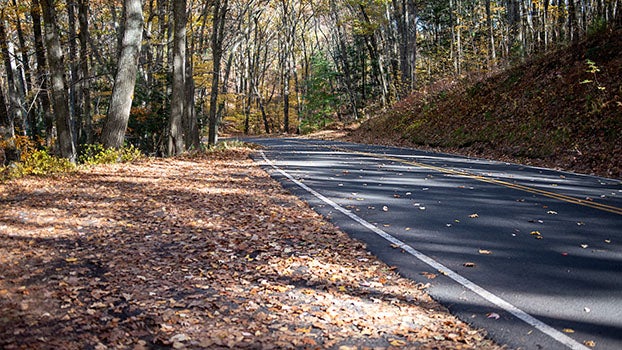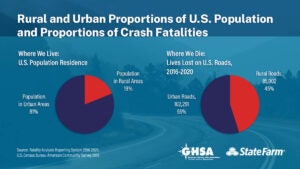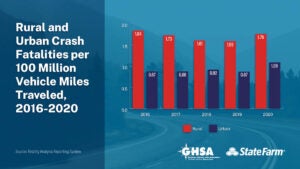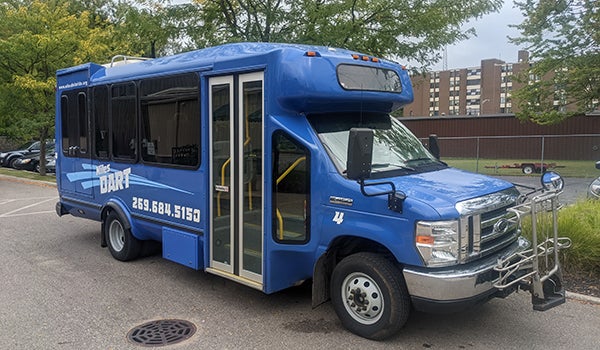Rural roads are disproportionately deadly, new study finds
Published 2:12 pm Friday, November 24, 2023

- (Photo courtesy of Rusty Watson)
|
Getting your Trinity Audio player ready...
|
WASHINGTON, D.C. — Rural roads are beautiful, but they’re hiding a deadly secret – nearly half of all fatal crashes occur on them, even though only 19 percent of the U.S. population lives in rural areas.
A September report from the Governors Highway Safety Association, funded by State Farm, explores the extent of the rural road safety problem and dives into the data to determine who dies in these crashes and what risky driving behaviors are key contributors. The report also offers nearly three dozen recommendations for State Highway Safety Offices and their partners to help make rural roads safer.
The report, “America’s Rural Roads: Beautiful and Deadly,” comes as traffic fatalities are soaring nationwide. Rural roads have been especially lethal in recent years. Between 2016 and 2020, the five most recent years of data, 85,002 people have died in crashes on rural roads. That’s more than the entire population of Scranton, Pa., or the seating capacity of Lambeau Field, home of the Green Bay Packers. In 2020, the risk of dying in a crash was 62 percent higher on a rural road compared to an urban road for the same trip length. While rural road deaths fell for several years before the pandemic, they increased in 2020, mirroring what happened across the country. Deaths on all types of rural roads – interstate, arterial and collector/local – increased further in 2021, according to preliminary National Highway Traffic Safety Administration data.
The high rate of crashes on rural roads is caused by several factors, including lack of safety resources, simpler roadway infrastructure, poor emergency medical services and to a significant extent, risky driver behaviors. The biggest culprits are not wearing a seat belt, impaired driving, speeding and distraction.
“Roads are the backbone of rural America, connecting far-flung communities and families. While cities and urban areas have alternatives to driving, that’s not the case for people in rural areas,” said GHSA Executive Director Jonathan Adkins. “Unfortunately, the dangerous and deadly driving behaviors that have increased during the pandemic have taken an oversized toll on rural residents. Making rural roads safer is essential for achieving the national goal of zero fatalities.”
To prevent these crashes and save lives, the report asks that states, tribes and their partners understand the unique challenges associated with rural roads – long distances, limited resources, cultural differences and more. The report offers a comprehensive look at the rural road issue through an in-depth analysis of federal data; input from an expert panel representing government, academic and nonprofit organizations; findings of a survey of SHSOs; and peer-reviewed and other relevant literature.
Rural Road Safety Trends, 2016-2020
The analysis of Fatality Analysis Reporting System data conducted for this report uncovered several details about fatalities in rural road crashes and what risky driving behaviors are key factors:
- Everyone is at risk on rural roads. However, men are involved much more than women – more than two to one – mirroring their over-involvement in crashes of all types. During the five-year period, 59,793 men died in rural road crashes compared to 25,151 women.
- The youngest drivers are at particular risk on rural roads. Although fatalities on rural roads involving 14 to 15-year-old drivers had declined between 2016 and 2019, they spiked in 2020, with rural fatalities for these young teen drivers jumping by 57 percent, mirroring the national uptick in roadway deaths in the first year of the pandemic.
- The risk to young drivers does not dissipate when they turn 18 years old. Instead, they continue to crash and die on rural roads well into their twenties – and at exceptionally high rates, the highest of any age group. Fatality rates then decline with age until the mid-forties when they climb again. Adults ages 65 and older make up 19 percent of the rural population but accounted for 21 percent of rural road deaths. This will only increase with the graying of the rural population.
- A lack of seat belt use is a hallmark of fatalities on rural roads. More than half – 58 percent – of U.S. motor vehicle occupants killed in rural road crashes during the five-year period were unrestrained. By comparison, in 2020, 51 percent of all road fatalities were unbelted.
- Speeding is a safety problem on all types of roads, but especially in rural areas, where it was a factor in 27 percent of deaths. Nearly half– 46 percent – of fatalities in crashes that involved speeding occurred on rural roads. Additionally, states with high maximum speed limits tend to have higher per capita rates of fatalities on rural roads than states with lower maximum speed limits.
- Alcohol and drug use are also key factors, as 43 percent of alcohol-related motor vehicle fatalities occurred on a rural road. Drug-impaired drivers killed 2,644 people on rural roads in 2020, but that figure is likely an undercount, as nearly twice as many crash deaths (5,335) have no information about potential drug involvement.
- Of all fatalities that involved distraction, 46 percent occurred on rural roads – far more than the population would predict. At least 7,699 people died on rural roads in crashes involving driver distraction over the five-year period, although data are limited because distraction can be difficult for law enforcement or crash scene investigators to ascertain.








